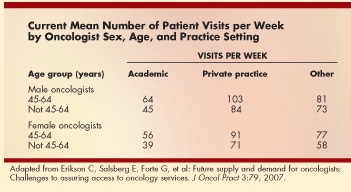ASCO Study Predicts Major Shortfall of Medical Oncologists by the Year 2020
A newly released ASCO study, titled "Future Supply and Demand for Oncologists: Challenges to Assuring Access to Oncology Services," projects a potential shortfall of medical oncologists in the United States, which could severely compromise access to quality care. Cancer Care & Economics (CC&E) recently spoke with Michael Goldstein, MD, an oncologist at Beth Israel Deaconess Medical Center, Boston. Dr. Goldstein, chair of the ASCO Workforce in Oncology Task Force, contributed to the development and analysis of this important study.
A newly released ASCO study, titled "Future Supply and Demand for Oncologists: Challenges to Assuring Access to Oncology Services," projects a potential shortfall of medical oncologists in the United States, which could severely compromise access to quality care. Cancer Care & Economics (CC&E) recently spoke with Michael Goldstein, MD, an oncologist at Beth Israel Deaconess Medical Center, Boston. Dr. Goldstein, chair of the ASCO Workforce in Oncology Task Force, contributed to the development and analysis of this important study.
CC&E: What was the impetus for the ASCO study?
DR. GOLDSTEIN: Several years ago, practices around the country reported having difficulty recruiting new oncologists. Detecting a potential trend, ASCO met with committees and staffers on Capitol Hill and related what we perceived as a growing shortfall of medical oncologists. The legislators asked ASCO to produce hard data to back up the claim, and, as a result, ASCO commissioned a study to analyze the future supply and demand scenario for oncology services across the nation.
CC&E: Please explain the data collection methodology.
DR. GOLDSTEIN: ASCO contracted with the Association of American Medical Colleges (AAMC) to do the actual clinical data gathering under our direction. The study had four parts. We surveyed fellows who were just starting their oncology training program; fellows who had just completed an oncology training program; oncology fellowship program directors; and about 4,000 practicing oncologists around the United States. The study drew upon National Cancer Institute (NCI) analyses of Medicare data to estimate future demand and utilization of oncologist services.
CC&E: What is the projected shortfall of medical oncologists?
DR. GOLDSTEIN: If the current trends continue, by the year 2020 there could be a shortfall of somewhere between 2,500 and 4,000 medical oncologists, roughly one-quarter to one-third of the supply we had in 2005. This translates into a shortage of patient visits upward of 15 million.
CC&E: What is the primary reason for the potential shortfall?
DR. GOLDSTEIN: It simply boils down to higher demand for services and lower supply of doctors. Given the time and resources it takes to expand the oncology workforce, we simply won't be able to meet the growing demand driven by our aging population. We estimate that the number of oncologists produced 15 years from now will exceed the present number by around 14%, whereas the demand for services will be up approximately 48%.
CC&E: Did the study identify any behavioral characteristics that might shed light on the problem?
DR. GOLDSTEIN: We analyzed the productivity of practicing oncologists and found that physicians aged 45 to 64 are the most productive in terms of per-week visits (see Table). It also became clear that lifestyle considerations are much more important to the new generation of physicians than they were to the older generation. People entering practice today expect, rightly so, to have a more harmonious balance between their personal life and their work life. However, if new physicians actively decide to work fewer hours or see fewer patients, it would increase the projected numerical shortfall.

Interestingly, when we surveyed oncologists about dissatisfactions with their practice, dealing with sick and dying patients and economic factors were not major issues. Instead, one of the major reasons oncologists consider leaving their practices early is the procedural hassles associated with delivering cancer care today that didn't exist 15 or 20 years ago, such as excessive paperwork and overarching government regulations.
CC&E: How do we turn this trend around before it impacts access to oncology services?
DR. GOLDSTEIN: Well, there are a number of possibilities. First, I think the oncologists of tomorrow will need to be different from today's practitioners. They will probably be more of a team leader, overseeing care delivered by physician extenders, ie, highly skilled nurse practitioners and physician assistants. Moreover, greater use of technology will help streamline efficiencies and reduce the burden of excessive paperwork.
We have to find ways to increase fellowship positions and perhaps create incentives to delay the retirement of existing oncologists. And, as we deal with more cancer survivors, we'll need additional personnel specially trained in survivorship care to ease the burden on oncology practices.
CC&E: Does ASCO plan to bring this issue to policymakers on the Hill?
DR. GOLDSTEIN: Absolutely. ASCO will work with legislators to try to increase federal funding dedicated to training more physicians. Increased funding is not the sole answer, but if we can produce more oncologists 10 to 15 years down the line, it will certainly alleviate some of the expected shortage.
ASCO also has created a 14-member Workforce Implementation Group, which I co-chair, to develop strategies and recommendations by the end of the year that will address the projected oncologist shortfall.
CC&E: Any closing thoughts?
DR. GOLDSTEIN: As noted, the ASCO survey shows that the country is facing major challenges in our capacity to meet the growing demand for oncology services. There's no single solution to this problem, but concerted action over the next several years can certainly minimize the crisis.
We also need to find better ways to maximize the use of our limited supply of oncologists, which, in the long run, may lead to more effective approaches to delivering care.